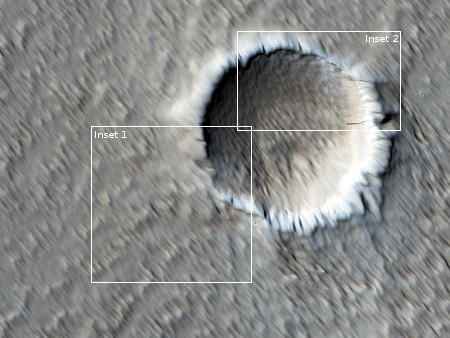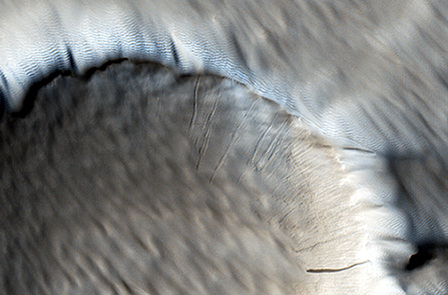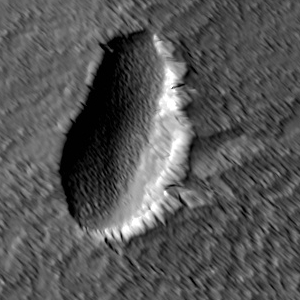Mars’ weird windblown surface

Cool image time! The image on the right, taken by Mars Reconnaissance Orbiter (MRO) and cropped from a wider view of a small crater and a small volcano caldera, certainly appears blurred and out of focus. Is MRO malfunctioning?
Nope. The blurring is actually an optical illusion caused almost entirely by our own assumptions of what a planet surface should look like combined with the alien processes occurring on Mars that have no equivalent here on Earth.
Below the fold is a wider view from the full image, showing the area of the cropped image to the right as well as the entire crater. Below that is another full resolution inset, this time showing the features on the crater rim that are sharp and stand out clearly. The blurriness of the rest of the image is not because the image is out-of-focus, but because a steady northwest-to- southeast wind has distorted everything in the same direction.


As noted at the website:
When looking at the scene for the first time, the image seems motion blurred. However, upon a closer look, the smaller, young craters are pristine, so the image must be sharp and the “blurriness” is due to the processes acting on the terrain. This suggests that the deflation-produced grooves, along with the crater and the caldera, are old features and deflation is not very active today. Alternatively, perhaps these craters are simply too young to show signs of degradation.
This deeply wind-scoured terrain type is unique to Mars. Wind-carved stream-lined landforms on Earth are called “yardangs,” but they don’t form extensive terrains like this one. The basaltic lavas on the flanks of this volcano have been exposed to wind for such a long time that there are no parallels on Earth. Terrestrial landscapes and terrestrial wind patterns change much more rapidly than on Mars.

This still seems hard to believe, but to the right is another full resolution crop from the full image, this time showing the small volcanic caldara. That steady wind has not only pushed material right to the edge of the northwest rim so that some of it is overhanging the pit, it has pushed the material on the opposite rim away from the pit, smoothing it out in the process. You can even see one large chunk that has slide away, pushed in the direction of the prevailing winds.
As they note, there is no process like this on Earth. The images here demonstrate again that we need to be very careful about any initial conclusions we draw from pictures taken of the surface of an alien planet. Some things might look familiar, and in fact that similarity is often helpful in trying to decipher what is going on, but we must not assume that our initial interpretations are correct. The alienness of the surface could be fooling us.
On Christmas Eve 1968 three Americans became the first humans to visit another world. What they did to celebrate was unexpected and profound, and will be remembered throughout all human history. Genesis: the Story of Apollo 8, Robert Zimmerman's classic history of humanity's first journey to another world, tells that story, and it is now available as both an ebook and an audiobook, both with a foreword by Valerie Anders and a new introduction by Robert Zimmerman.
The print edition can be purchased at Amazon or from any other book seller. If you want an autographed copy the price is $60 for the hardback and $45 for the paperback, plus $8 shipping for each. Go here for purchasing details. The ebook is available everywhere for $5.99 (before discount) at amazon, or direct from my ebook publisher, ebookit. If you buy it from ebookit you don't support the big tech companies and the author gets a bigger cut much sooner.
The audiobook is also available at all these vendors, and is also free with a 30-day trial membership to Audible.
"Not simply about one mission, [Genesis] is also the history of America's quest for the moon... Zimmerman has done a masterful job of tying disparate events together into a solid account of one of America's greatest human triumphs."--San Antonio Express-News

Cool image time! The image on the right, taken by Mars Reconnaissance Orbiter (MRO) and cropped from a wider view of a small crater and a small volcano caldera, certainly appears blurred and out of focus. Is MRO malfunctioning?
Nope. The blurring is actually an optical illusion caused almost entirely by our own assumptions of what a planet surface should look like combined with the alien processes occurring on Mars that have no equivalent here on Earth.
Below the fold is a wider view from the full image, showing the area of the cropped image to the right as well as the entire crater. Below that is another full resolution inset, this time showing the features on the crater rim that are sharp and stand out clearly. The blurriness of the rest of the image is not because the image is out-of-focus, but because a steady northwest-to- southeast wind has distorted everything in the same direction.


As noted at the website:
When looking at the scene for the first time, the image seems motion blurred. However, upon a closer look, the smaller, young craters are pristine, so the image must be sharp and the “blurriness” is due to the processes acting on the terrain. This suggests that the deflation-produced grooves, along with the crater and the caldera, are old features and deflation is not very active today. Alternatively, perhaps these craters are simply too young to show signs of degradation.
This deeply wind-scoured terrain type is unique to Mars. Wind-carved stream-lined landforms on Earth are called “yardangs,” but they don’t form extensive terrains like this one. The basaltic lavas on the flanks of this volcano have been exposed to wind for such a long time that there are no parallels on Earth. Terrestrial landscapes and terrestrial wind patterns change much more rapidly than on Mars.

This still seems hard to believe, but to the right is another full resolution crop from the full image, this time showing the small volcanic caldara. That steady wind has not only pushed material right to the edge of the northwest rim so that some of it is overhanging the pit, it has pushed the material on the opposite rim away from the pit, smoothing it out in the process. You can even see one large chunk that has slide away, pushed in the direction of the prevailing winds.
As they note, there is no process like this on Earth. The images here demonstrate again that we need to be very careful about any initial conclusions we draw from pictures taken of the surface of an alien planet. Some things might look familiar, and in fact that similarity is often helpful in trying to decipher what is going on, but we must not assume that our initial interpretations are correct. The alienness of the surface could be fooling us.
On Christmas Eve 1968 three Americans became the first humans to visit another world. What they did to celebrate was unexpected and profound, and will be remembered throughout all human history. Genesis: the Story of Apollo 8, Robert Zimmerman's classic history of humanity's first journey to another world, tells that story, and it is now available as both an ebook and an audiobook, both with a foreword by Valerie Anders and a new introduction by Robert Zimmerman.
The print edition can be purchased at Amazon or from any other book seller. If you want an autographed copy the price is $60 for the hardback and $45 for the paperback, plus $8 shipping for each. Go here for purchasing details. The ebook is available everywhere for $5.99 (before discount) at amazon, or direct from my ebook publisher, ebookit. If you buy it from ebookit you don't support the big tech companies and the author gets a bigger cut much sooner.
The audiobook is also available at all these vendors, and is also free with a 30-day trial membership to Audible.
"Not simply about one mission, [Genesis] is also the history of America's quest for the moon... Zimmerman has done a masterful job of tying disparate events together into a solid account of one of America's greatest human triumphs."--San Antonio Express-News


The images here demonstrate again that we need to be very careful about any initial conclusions we draw from pictures taken of the surface of an alien planet.
Hmm, a possible conclusion to draw from this picture is to avoid this area when picking a site for a colony or some other activity other than studying sandblasting on Mars.
To overhang, the material must be very cohesive.
To my eye the surface looks a lot like degraded snow drifts. Or drifted snow that has seen warmer temperatures and then re-freezes.
I have seen this kind of blurring in some aircraft contrails. And some t-shirt fonts.